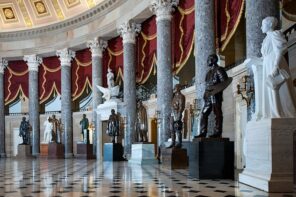For all the ink spilled on Alexander Hamilton by historians, and for all the buzz generated by the Hamilton musical, there’s a hidden history to this iconic founder that never made its way to the page or the stage: Hamilton was probably Jewish. His origins have long remained concealed behind a veil of unfounded assumptions. The work of debunking those myths reveals the very real possibility of Hamilton’s Jewish identity and gestures toward a new way of thinking about the American founding.
If Jewish identity begins with the mother, then so must this story. Hamilton’s mother, Rachel, was born a Gentile on the British Caribbean island of Nevis. When she was around sixteen, she moved to St. Croix in the Danish West Indies where she soon married a merchant named Johan Levine in 1745. The balance of evidence in the historical record suggests the following: Johan was Jewish, Rachel converted to Judaism to marry him, and she raised her son Alexander in her adopted faith.
Let us begin with Johan Levine. Hamilton scholars have long expressed skepticism that Levine had a Jewish identity on the grounds that the Danish records did not classify him as Jewish. But, as it turns out, those records almost uniformly failed to note religious identity for anyone, Jew or Gentile. What’s more, several other known details about Johan accord with the theory that he was a member of the Jewish people. Johan’s surname appears in certain variations—including “Lewin” and “Levin”—that match how Jews of Levitic descent spelled their last names. Johan’s work as a merchant was typical of contemporary Jews. What’s more, he had come to St. Croix from Nevis, where one-quarter of the free population was Jewish. And Hamilton’s own grandson would later describe Johan as a “rich Danish Jew.”
The year after their wedding, Rachel and Johan had a son, Peter. What little we know about Peter lends further credence to the notion that Johan was a Jew and that Rachel became one. As an adult, Peter would undertake an adult baptism to join the Anglican Church, a facet of the story that has left Hamilton biographers baffled. After all, if Peter was born Christian—as historians assume—then he would have already been baptized as an infant, with no conceivable need for an adult baptism. If, however, Johan was Jewish, and Rachel converted to Judaism to marry him, then the matrilineal nature of Jewish identity made Peter a Jew. An adult baptism would thus have been a necessary step in Peter’s conversion from Judaism to Christianity.
Rachel and Johan had a troubled marriage, and she was imprisoned in 1749 on account of her infidelity. When she was released from her incarceration in 1750, she absconded from St. Croix, leaving behind her vengeful husband and their young son. Rachel eventually made her way back to her native island of Nevis, where she bore Alexander out of wedlock to a Scottish colonist named James Hamilton. Although James was unquestionably a Gentile, there is substantial cause to think that Rachel retained a Jewish identity and passed it on to Alexander.
The baptismal records are fragmentary, but those that do survive show no entry for him. Even more compelling is the fact that Rachel enrolled Alexander in a Jewish school where he began rudimentary study of the Torah in the original Hebrew. “Rarely as he alluded to his personal history,” his son once recounted of Alexander, “he mentioned with a smile his having been taught to repeat the Decalogue [i.e. the Ten Commandments] in Hebrew, at the school of a Jewess, when so small that he was placed standing by her side upon a table.”
Hamilton biographers have long known that there’s no extant baptismal entry for him and that he had a Jewish education. They shrug off these curiosities, peddling a theory that Hamilton’s illegitimacy barred him from both baptism and church schooling. This tidy explanation, however, doesn’t withstand scrutiny. Both on Nevis and throughout the Caribbean, church records show instances of children who were “bastards” yet baptized. We have precious little grounds for assuming that Hamilton’s out-of-wedlock birth posed an obstacle to his acceptance into church life.
Moreover, scholars make a critical error in supposing that a Jewish school would have educated a child who was considered Christian. Jewish schools were religious instruments. Their core mission was to turn Jewish children into observant Jewish adults. And the Talmud prohibits the teaching of the Torah to Gentiles. For these reasons, the enrollment of any given child at a Jewish school in this era is a strong indicator that the child was a Jew in the eyes of the local community.
The fraught nature of Jewish-Christian relations in the West Indies raises further doubts about the conventional wisdom that the Jewish school would have taken in a student who was considered Christian. Jews on Nevis and other islands faced legal discrimination and cultural prejudice. Various forms of segregation between Jews and Gentiles were part of daily life on Nevis. Admitting a Christian student into the Jewish school would have prompted accusations that Jews were trying to Judaize the children of Christian families, precisely the kind of outcome that Jews sought to avoid. It strains believability to imagine that in a prejudicial climate like Nevis, local Jews would have hazarded that kind of risk.
Hamilton’s mother tragically passed away when he was only thirteen, and it appears that any Jewish affiliation he might have had died with her. He didn’t identify as Jewish in his American adulthood nor did he disclose to anyone a hint of his Jewish past. In fact, Hamilton largely remained silent about all aspects of his West Indian origins. And yet his early exposure to the people and faith of Judaism appears to have left an enduring mark: no other American founder cultivated closer ties to the Jewish community in America.
In the wake of the Revolution that Hamilton waged alongside fellow patriots—both Gentile and Jew—the new republic confronted a momentous question: Would the radical promise of equality enshrined in the Declaration of Independence now translate into democratic realities? A number of politicians sought to withhold the prerogatives of citizenship from Jews, from the courthouse to the ballot box. Against these forces of antisemitism, Alexander Hamilton sought to build an America where Jew and Gentile would stand as equals. He helped break barriers to Jews in academia, invigorated a marketplace that afforded Jews their greatest opportunities, and fulminated against antisemitism in the courts.
The question of Jewish belonging in America has resurfaced with disturbing vigor in recent years. Much of the animus toward Jews is premised on a mythic rendition of American history, one in which Gentiles were the original founders of the country and Jews are interlopers who somehow threaten the fundamental character of the nation. The story of Alexander Hamilton offers a surprising reminder that Jews have been a part of the American experiment since its very inception. If Jew-hatred in the United States is as old as the country itself, then so too is the fight to secure equality for the Jewish people.





